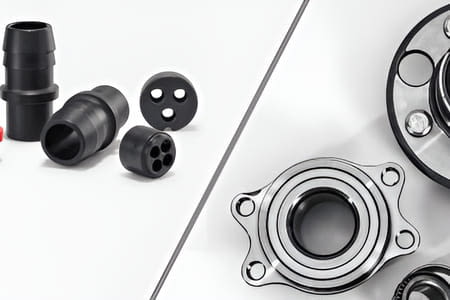
The parts machining sector has been developing new methods and techniques to achieve better results in their applications. At Induplast, we have many years of experience working hand in hand with R&D departments and this has given us extensive experience and knowledge about the manufacturing and machining of industrial parts. Throughout these years we have discovered the efficiency that certain materials offer in comparison to others, as is the case of plastic compared to other alternatives such as metals.
In today’s post we are going to talk about the differences between both materials and the advantages that plastic can offer over metal.
Plastics are becoming increasingly common in the industrial sector thanks to their cost and the technical benefits that they can bring when substituting for metal. Firstly, technical applications require parts with very specific features, in this scenario, plastic offers better elasticity and can be moulded more easily. This allows more complex shapes to be created than with other heavier or stiffer materials. Another benefit that plastic offers is that it is corrosion resistant, unlike metals it does not rust and can be exposed to extreme environments without damage. It is also resistant to chemical products.
The main disadvantage of engineering plastics is that they release less heat, which can cause the material to overheat and expand. In plastic machining processes this factor must be taken into account. On the other hand, metal is more rigid and has a lower risk of deformation.
Finally, one of the great qualities of engineering plastics should be highlighted: electrical insulation.
Generally, engineering plastics can be used as substitutes for other alternative materials such as metals. Not only thanks to their economic advantage but also the technical advantages that they bring to part manufacturing. At Induplast, we have many years of experience working with engineering plastics and we can guarantee the efficiency of this type of material.
This is only a brief look at the differences between materials. If you need further information on any of these aspects, take a look at the engineering plastics on our website, or contact us. We will be happy to help you.
In today’s post we are going to talk about the differences between both materials and the advantages that plastic can offer over metal.
Plastics are becoming increasingly common in the industrial sector thanks to their cost and the technical benefits that they can bring when substituting for metal. Firstly, technical applications require parts with very specific features, in this scenario, plastic offers better elasticity and can be moulded more easily. This allows more complex shapes to be created than with other heavier or stiffer materials. Another benefit that plastic offers is that it is corrosion resistant, unlike metals it does not rust and can be exposed to extreme environments without damage. It is also resistant to chemical products.
The main disadvantage of engineering plastics is that they release less heat, which can cause the material to overheat and expand. In plastic machining processes this factor must be taken into account. On the other hand, metal is more rigid and has a lower risk of deformation.
Finally, one of the great qualities of engineering plastics should be highlighted: electrical insulation.
Generally, engineering plastics can be used as substitutes for other alternative materials such as metals. Not only thanks to their economic advantage but also the technical advantages that they bring to part manufacturing. At Induplast, we have many years of experience working with engineering plastics and we can guarantee the efficiency of this type of material.
This is only a brief look at the differences between materials. If you need further information on any of these aspects, take a look at the engineering plastics on our website, or contact us. We will be happy to help you.







